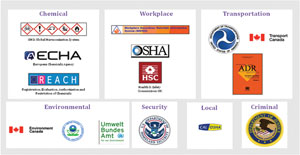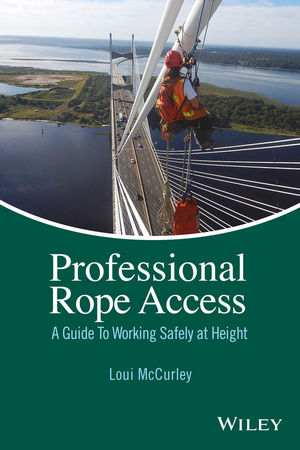More than two years after the Globally Harmonized System for Classification and Labeling of Chemicals (GHS) Notice of Proposed Rule Making (NPRM) to revise the existing Hazard Communication Standard (HCS) was introduced, OSHA finalized the new rule and significantly amended the 29 CFR, effective May 26, 2012. The revised OSHA HCS (hereafter referred to as HazCom 2012) is based on the 3rd Revised Edition of the Purple Book (the UN’s published guide for GHS) with some content drawn from the 4th Revised Edition.
The U.S. was not an early adopter. New Zealand led the way in 2001, and was quickly followed by a wave of Asia-Pacific nations. The EU adopted its version in 2009. A number of factors extend the timeline for complete global harmonization:
1. It’s optional — there is no global mandate.
2. Nations can pick and choose which sections in the Purple Book to implement, omitting perceived negative obligations.
3. If participating countries have specific data requirements, etc. not specifically called out in the Purple Book, GHS does not restrict inclusion of additional information on labels and safety data sheets (SDSs).
4. Most countries have opted for staggered timelines to adopt the GHS, thus easing into implementation
5. Purple Book Revisions — Currently, there are four editions of the Purple Book. Participants can apply sections from a combination of versions.
All this may look like the most unharmonized harmonized system in the world, but the intent is to use flexibility for continuous movement toward a true GHS.
Lifecycle compliance
Fragmented implemenation of GHS increases chemical compliance challenges. Multiple disciplines of country-specific agencies are affected: those that regulate manufacturing, transport, use, disposal, workplace safety, environmental safety, national security and community safety.
Taking a lifecycle strategy to GHS tasks facilitates conformance or compliance. This covers hazardous substances and materials from cradle to grave and is widely accepted as an industry best practice. It integrates into a single managed system what were once separate silos of expertise, technology, data and applicable regulations (R&D, manufacturing, transport, use and disposal).
To incorporate GHS into chemical lifecycle management:
– Outline your compliance framework NOW, predetermining
Roles and responsibilities at a corporate, site, field level
Number of employees to be trained / estimated training hours required
Number of work sites impacted
Number of plant managers and safety professionals involved / estimated time requirement
Number of product MSDS to be revised
– Develop a capacity plan to address the transition and all required changes
– Conduct a resource assessment
– Develop a draft training plan
– Analyze required infrastructure revisions and upgrades
Expanded data fields
GHS symbols/pictograms
New label templates for internal containers
– Analyze required internal process changes
– Evaluate impact of GHS re-classification
– Analyze and confirm vendor capabilities to improve compliance
Internal operations and disciplines (product stewardship, industrial hygiene, procurement, environmental, production, safety, shipping, etc.) depend on an integrated system to provide immediate access to data and analytical tools to achieve compliance and assist in decision-making. Other internal entities (sales, marketing, risk management, quality assurance) are also impacted. The role of downstream users (customers and consumers) is expanding as their requests for chemical lifecycle data increase.
Data sources: Data sources include SDSs, which have evolved into a prolific data source for EHS information that extends far beyond workplace safety. The promulgation of GHS has modified and expanded the amount of valuable data that will be included on all SDS and incoming product labels (see Hazcom 2012 SDS and label data).
Hazcom 2012 SDS and label data
Hazcom 2012 SDS format and content requirements (as defined in Appendix D of 29CFR 1910.1200). Sections are titled and must be listed in the order below.
1. Identification
2. Hazard(s) identification
3. Composition/information on ingredients
4. First-aid measures
5. Fire-fighting measures
6. Accidental release measures
7. Handling and storage
8. Exposure controls/personal protection
9. Physical and chemical properties
10. Stability and reactivity
11. Toxicological information
12. Ecological information*
13. Disposal considerations*
14. Transport information*
15. Regulatory information*
16. Other information, including date of preparation or last revision
*Sections 12-15 are outside of OSHA’s jurisdiction. They must be included in the format, but content is not required.
Hazcom 2012 GHS label components:
1. Product Identifier
2. Pictograms
3. Signal word
4. Precautionary Statements
5. Hazardous Statements
6. Supplemental Information
7. Supplier Identification
As the population of data in Sections 12-15 is not mandatory, product information not directly listed on the SDS must be sourced. Classification data specific to storage, regulatory reporting, transport and disposal is often not included or is insufficient to complete the decision-making process. Substance level data is required for upstream processes.
EMIS: This is the spring that will feed data and decision-making tools into an organization. Implementation and upgrading of an EMIS transitions internal compliance from a scattered, incomplete, out-dated, incongruent set of practices and information to a current, accurate and consistent data and decision-making source.
EHS outsourcing
Major regulatory revisions like GHS add layers of difficulty to existing compliance challenges. Contemplate the fundamental changes in Hazcom 2012 and consider the impact to your existing systems in:
1. Definitions (Accepted terminology replaced, revised or removed)
2. Hazard Classifications
3. Labels and Other Forms of Warning
4. Safety Data Sheets
5. Employee Information and Training
Outsourcing management of this information — how it is obtained, aggregated and integrated — and managing training obligations may be a better choice for your company.
Lifecycle Management (LCM) benefits
Benefits to properly managing the lifecycle include:
Consistency of data and document management, site-to-site/department-to-department, and QMS compliant
Data that has the leverage to support corporate EHS objectives, internal operations, external data requirements, regulatory compliance and workplace and community safety
Significant cost control and reduction, as effective LCM eliminates duplicate sources of information and increases efficiencies across supply chain
Improved product stewardship with the ability to react to and manage the impact of regulatory changes and the ability to support customers with product information
Efficient change management in which users can leverage a single change to all affected users and track changes to regulations, processes and protocols
Improved quality through automation and error proofing, also results in more accurate and current data and simplifies process documentation
LCM reduces dependence on tribal knowledge, lessens the impact of an aging EHS workforce and allows EHS professionals to focus on technical, compliance and regulatory issues
Getting started and keeping pace
To get started, first define and document your EHS information management requirements to conform to GHS. Next, is your data best internally managed or outsourced? It may also help to build a transition map from as-is to the LCM+HazCom 2012 model.
SIDEBARS
|
Hazcom 2012 SDS and label data Hazcom 2012 SDS format and content requirements (as defined in Appendix D of 29CFR 1910.1200). Sections are titled and must be listed in the order below. 1. Identification 2. Hazard(s) identification 3. Composition/information on ingredients 4. First-aid measures 5. Fire-fighting measures 6. Accidental release measures 7. Handling and storage 8. Exposure controls/personal protection 9. Physical and chemical properties 10. Stability and reactivity 11. Toxicological information 12. Ecological information* 13. Disposal considerations* 14. Transport information* 15. Regulatory information* 16. Other information, including date of preparation or last revision *Sections 12-15 are outside of OSHA’s jurisdiction. They must be included in the format, but content is not required. |
|
Hazcom 2012 GHS label components: 1. Product Identifier 2. Pictograms 3. Signal word 4. Precautionary Statements 5. Hazardous Statements 6. Supplemental Information 7. Supplier Identification |





